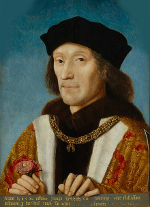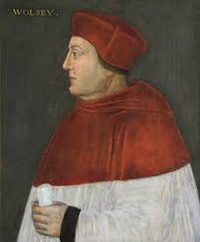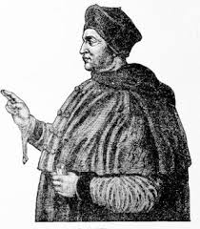Cardinal Thomas Wolsey: Henry VIII's Renaissance Man
He was born in early 1473 into a family that was relatively well off. He did his schooling at Ipswich School and then at Magdalen College, at Oxford, and then set about making a career in the church. He put his theology degree to good use and was ordained as a priest in 1498. At his alma mater, he served as Master and then Dean of Divinity. His next assignment was a rector of St. Mary's Church, in the Somerset settlement of Limington. 
Wolsey served as chaplain to a number of people and gained a reputation for being clever, intelligent, hard-working, and possessed with an excellent grasp of detail. One of those to whom he served as chaplain was Henry Deane, who was the Archbishop of Canterbury early in the 16th Century. (Also at this time, Wolsey was part of a diplomatic mission that cemented an alliance between England and Scotland in the form of the marriage of King James IV of Scotland and Margaret, daughter to King Henry VII.) Sir Richard Nanfan, for whom Wolsey served as chaplain, is the man who recommended Wolsey for a job in the king's service, as secretary to Richard Foxe, who served in various bishop postings, the most influential of which was Bishop of Winchester. King Henry VII appointed Wolsey as his personal chaplain in 1507. When the king died two years later, Wolsey continued in the role of personal chaplain to the new king, King Henry VIII. Wolsey improved his standing with the king and became known as the unofficial royal secretary. He proved to be very good at the job, and the king rewarded the chaplain with several lands and titles, which translated into a good deal of money. Henry named him bishop for three regions and abbot for two. 
Wolsey liked to live lavishly and enjoyed more than one spacious residence, the most famous of which was Hampton Court, later a favorite of Henry VIII and several subsequent monarchs. Proving his acumen in foreign affairs as well, Wolsey helped convince the king to go to war with France in 1511. Pope Julius II had issued a plea for help against what he feared was a growing threat from France, in the form of Louis XII. England negotiated an alliance with not only the Pope but also King Ferdinand V of Spain and Holy Roman Emperor Maximilian I. The alliance held for two years, winning control of two cities in France and forcing an overall French retreat that ended in a treaty, in 1514, that resulted in Louis' marrying Henry's other sister, Mary. While Henry, Wolsey, and England were focused on the Continent, Scotland chose to make yet another incursion into northern England. King James IV at the head of an army of 20,000 invaded in 1513. The invasion was spectacularly unsuccessful, ending in an English victory at the Battle of Flodden Field on Sept. 9, 1513, which also resulted in the death of James IV. The king appointed Wolsey Chancellor, or chief minister, in 1515. He held this position for 24 years. Wolsey gained appointment as a cardinal in 1515 and as Legate a latere three years later, at the instigation of a new Pope, Leo X. With this position came even more power, this time in the church itself. 
The kings of France and Spain and the Holy Roman emperor died. The various machinations that saw different leaders vying for the throne of the Holy Roman Empire resulted in an unofficial alliance against the new French king, Francis I. Against this backdrop of political intrigue, Wolsey organized a 20-nation peace summit in order to forge a Continent-wide alliance in a new Crusade against the Ottoman Empire. Wolsey further added to his international prestige by organizing the Field of the Cloth and Gold, a 1520 meeting of his king and France's king punctuated by large amounts of pomp and ceremony that paved the way for friendlier relations between the two countries. Wolsey also succeeded in negotiating an alliance with Spain and its new king, Charles V, in 1521, a reversal of a Franco-Spanish alliance that had been in place a few years earlier. Also at this time, Wolsey played a major role in exposing the efforts of Edward Stafford, Duke of Buckingham. Henry had Buckingham executed after the latter was found guilty of planning to overthrow the king and put himself on the throne. All of this power and wealth made Wolsey the envy of many and the enemy of a select, wealthy few. He had the support of the king, however, and that was enough to keep him from harm. Wolsey put his managerial acumen to work running the government, also streamlining the legal system. He reformed the equity court, in which a judge used fairness as a basis for making decisions. He also re-established the prominence of the Star Chamber and the Court of Chancery. He lacked financial expertise initially but crafted a revision to the taxation system based on a citizen's wealth that was effective enough to produce enough revenue to keep up with the king's voluminous spending. One tax scheme engineered by Wolsey, enacted when Parliament refused to grant Henry any more money for fighting wars, caused quite a bit of resistance. The Amicable Grant of 1525 equated to a forced loan. Many people refused to hand over the required money, and Wolsey abandoned the program. 
When Henry VIII tired of having Catherine of Aragon as his wife and wanted to divorce her and marry one of her ladies-in-waiting, Anne Boleyn, the king handed Wolsey the task of convincing the Pope to grant an annulment that would sever the marriage of the king and queen. With powerful forces stacked against him (not the least of whom was the Holy Roman Emperor, Charles V, who was the nephew of Catherine of Aragon), Wolsey was unable to get the Pope to grant the annulment. (This despite the support of France's King Francis I, which Wolsey had cemented at the Field of the Cloth of Gold.) Frustrated, Henry removed Wolsey from the position of Chancellor and then from various religious positions. The queen was already not much enamored with Wolsey and his methods, and his role in seeking the annulment strained their relationship further. One of Wolsey's enemies was the family of Anne Boleyn. Their influence with the king and Wolsey's inability to convince the Pope to annul the king's marriage proved too much for Henry, and he removed Wolsey from all positions and had him arrested, in November 1530. Wolsey was in York at the time, serving as Archbishop of York, and so was on his way to London, to be locked up in the Tower, when he died. He breathed his last at Leicester Abbey on November 29. As a final indignity, Henry took control of Hampton Court. Thomas Wolsey never married, being prohibited from doing so by the laws of the church. He lived with a woman named Joan Larke for a considerable period of time, and the two had two children together. |
|
Social Studies for Kids
copyright 2002–2025
David White



 Thomas Wolsey was a religious man who enjoyed great success as an advisor to England's King Henry VIII. He had a variety of top-notch skills that served him well as the king's Chancellor. Like several others in his position, he fell out of favor with the king and met a premature end.
Thomas Wolsey was a religious man who enjoyed great success as an advisor to England's King Henry VIII. He had a variety of top-notch skills that served him well as the king's Chancellor. Like several others in his position, he fell out of favor with the king and met a premature end.
